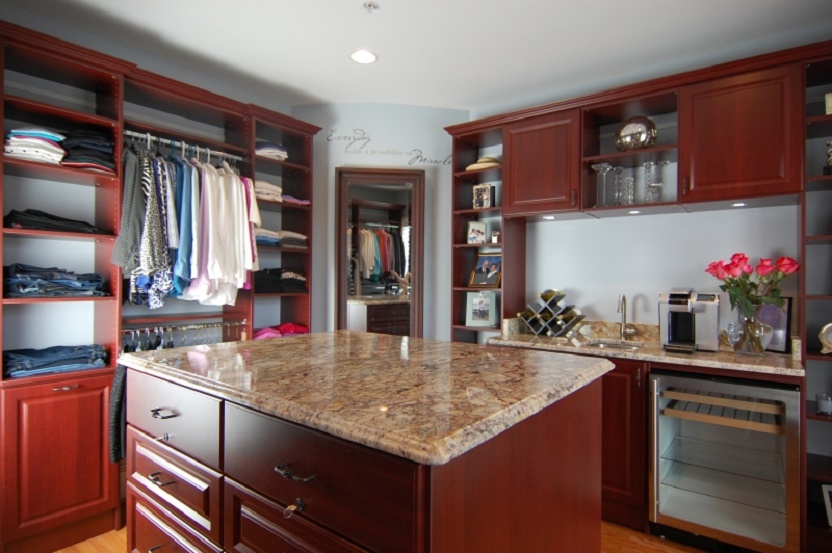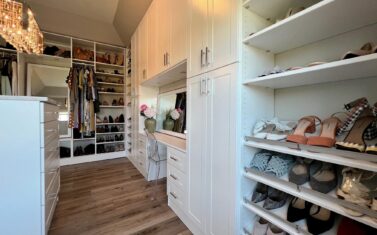
Closet Islands vs. Peninsulas: Design Pros and Cons
3 minute read, by Closet America, on Dec 30, 2016
Islands are a popular design feature for walk-in closets, but what’s the difference between closet islands and a peninsula? And which one should you choose?
When my clients are figuring out what features they want in their walk-in closets, one of the questions I hear frequently is, “Which is better: an island or a peninsula?” My answer? It depends! Each option has benefits and drawbacks, and since these pieces are custom, your closet designer will often look at the layout of your walk-in to determine the best solution.
That being said, I’ve rounded up a few of the more general pros and cons for each choice. Take a look and decide which works best for you and your custom closet.
Islands: The Pros
An island has the ability to give your closet a more impressive appearance while providing tons of useful functions. Here’s what I especially love:
-
Islands add serious storage space. I have yet to come across a client who doesn’t want extra storage in their master closet. Islands are a great spot for adding jewelry drawers, shelving for additional handbags or shoes, and space for slide-out accessories like laundry hampers and ironing boards.
-
They’re good for laundry and wardrobe planning. Especially if you dread laundry day, having a large surface area for sorting and folding can be a godsend. I’d also recommend an island If you’re an outfit planner and like to put all your clothes and accessories in one spot before getting dressed.
-
You have room to decorate. The large counter top of an island is a great spot for displaying favorite items. Whether you’ve got hat stands, decorative bowls, or tabletop mirrors you want to show off, these small touches help your closet feel more like a boutique than a storage space.
Islands: The Cons

But as much as I love islands, they’re not always the best fit for everyone:
-
Islands take up a lot of floor space. If your walk-in isn’t especially large, and you really want an open, spacious feeling, an island isn’t a good option. It’s true that Closet America does create custom closet storage systems, so we can certainly scale down the closet design, but either way, an island will significantly reduce the amount of space you’ve got available and can overpower a small area.
-
They make closet maintenance more challenging. Extra storage is great, but all the drawers and shelves in the world won’t do you any good if you can’t keep them organized. I’d suggest having a specific plan in place for what you want to store in your island. This keeps every drawer from turning into a junk drawer.
Peninsulas: The Pros
With all that an island offers, you’re probably wondering how a closet peninsula could be better. There are a couple of reasons these little guys warm my heart:
-
They are space savers. While peninsulas still take up room, they’re less overwhelming. They also have an L-shaped footprint versus the rectangular structure of islands, which means that, while they can help break up your space visually, they’re less likely to leave you feeling like half your closet is closed off.
-
They help combat messiness. For some people, too much counter space is an instant way to accumulate clutter. Because peninsulas have a limited surface, it’s easier to keep the space tidy and commit to using it efficiently.
Peninsulas: The Cons

Before you fall in love with peninsulas, consider a couple of drawbacks:
-
They take space away from your shelving system. What you free up in floor space, you lose in wall space. This means you might have to sacrifice shelving or cabinetry or make peace with the fact that any storage directly above or behind the peninsula will be more difficult to access.
-
They don’t offer much room for accessory features. While we can design peninsulas to include some storage, they aren’t usually as wide or deep as islands. This means you might have to make a choice between, say, a couple of extra drawers and a tilt-out hamper.
Islands and peninsulas definitely have their own quirks. I love both, but figuring out which one to choose will ultimately depend on what you want out of your space. If you’re still on the fence, no worries. Ask one of our designers to stop by for a free consultation, and we’ll help you figure it out.




